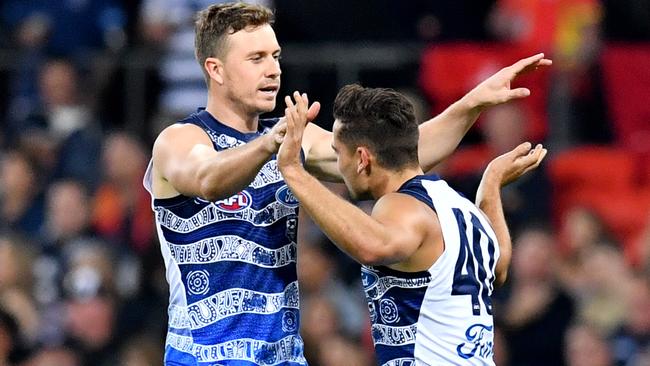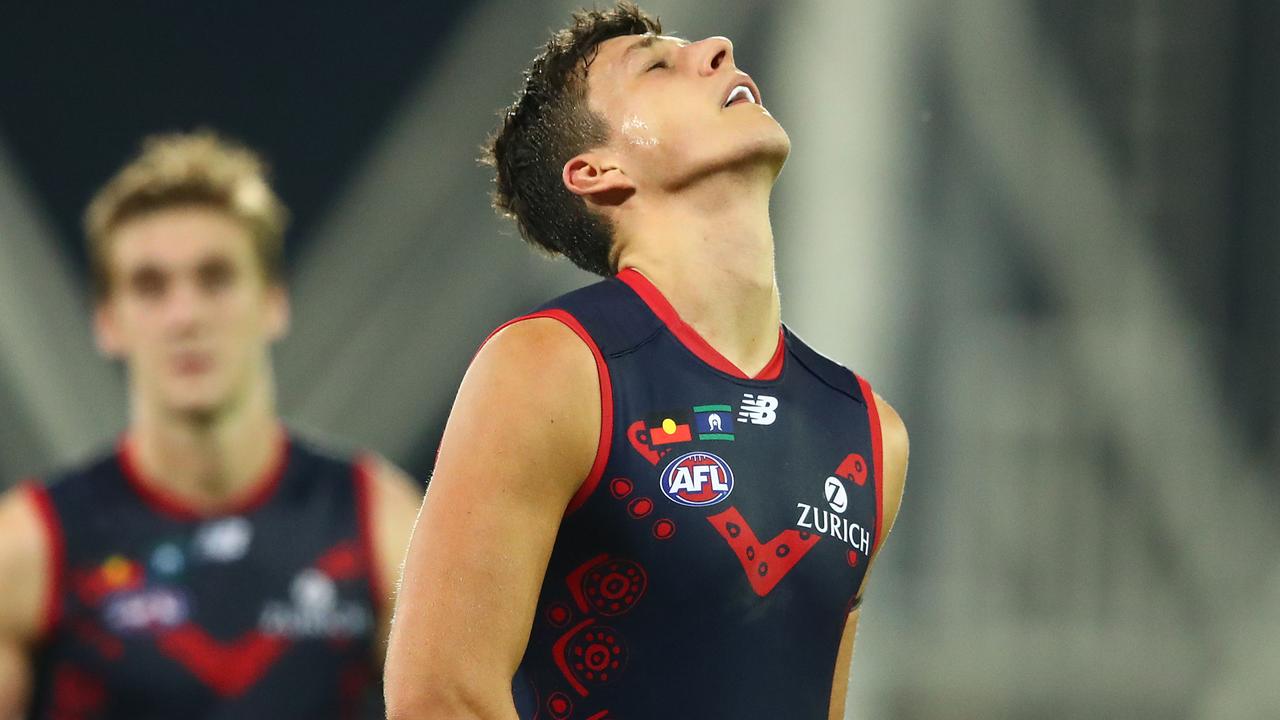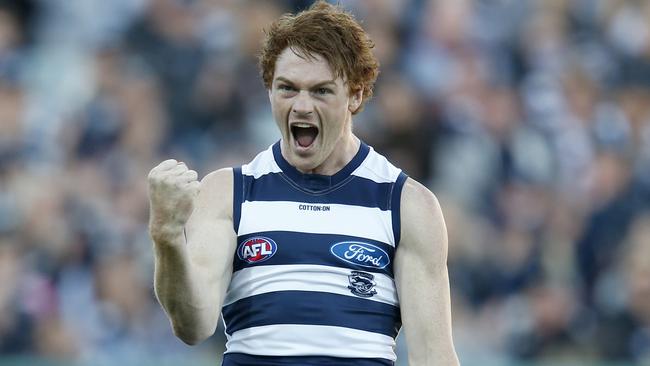Geelong has become the most lethal finishing side in the AFL after changing the way it approaches goal kicking
The most remarkable statistic of the season is that Geelong, the team which sits two games clear on top of the ladder, is 11th for inside 50s. Jay Clark breaks down how the Cats have solved the game’s scoring curse.

Geelong
Don't miss out on the headlines from Geelong. Followed categories will be added to My News.
They have become the most lethal finishing side in the competition.
And 11 rounds into the new season, Geelong’s surge to the top of the ladder has shone a light on a new tactical direction.
CLICK HERE TO SUBSCRIBE TO THE SUPERFOOTY PODCAST
Since Sydney’s premiership win in 2005, the defensive aspects of footy have largely dominated, leaving scoring at a 50-year low.
The AFL stepped in last year and introduce radical rule changes to open up the game.
But West Coast and Geelong, in particular, have shown this season that in the forward half of the ground, efficiency is the new king.
Goal kicking training under fatigue and playing specialist forwards such as Gryan Miers helps to explain the Cats’ outstanding accuracy.
SUPERCOACH: ARE YOU MAKING THE RIGHT TRADES?
TEAMS: SEE WHO MADE THE CUT FOR ROUND 12
NOT HAPPY: INSIDE THE BUCKLEY V MICK FEUD
The most remarkable statistic is that Geelong, which sits two games clear on top of the ladder, is 11th for inside 50s.
In the past there was a strong correlation between winning the inside 50m count and winning the game.
In 2013, teams that won the inside 50m by 10-plus won 92 per cent of matches.
This season, the percentage has slumped to 77 per cent.
More relevant these days is the efficiency of the forward line and for Chris Scott’s men this season it’s all about quality, not quantity.

At the other end of the ladder, Melbourne has the second-most entries in the league, but one of the worst scoring conversion rates ever.
The Cats are using Samurai swords and the Demons are playing with plastic scissors.
Geelong has deliberately played skillful goal kickers ahead of the ball, taking easier shots inside 50m and dedicating training time to goal kicking under fatigue.
The bulk of this work is overseen by forwards coach Corey Enright and the main man, Scott.
The Cats and Swans both had 14 shots on goal in their game last Saturday. The margin was 29 points because Geelong had seven from either close range or straight in front.
This offensive growth in the game could rail against some of the shut down defensive mechanisms that have ground scoring to historic lows.
There was an exciting offensive wave when Geelong took the game on under Mark Thompson in 2007 and the Cats and Eagles could take the game in a new direction with this forward-half efficiency.
League headquarters is keen to see clubs have success offensively, to try to increase scoring across the league.
For the first time this season, 17 goals came from kick-ins last weekend.
But the main frustration is goal kicking accuracy, the one part of the game that hasn’t improved.
The Demons blew their chances to win the game against Adelaide last weekend, registering 1.8 in the final term. Max Gawn, James Harmes and Sam Weideman all missed crucial chances.

St Kilda great Nathan Burke said on Thursday goal kicking inaccuracy was “why I yell at the television”.
And the Cats have five of the most accurate goal kickers in the league in Tom Hawkins (31 goals 12 behinds), Gary Rohan (20.6), Gary Ablett (20.12), Miers (12.5) and Mitch Duncan (12.3).
Taking into account the position of the kick and the pressure the players are under, West Coast (+5.6 per cent accuracy differential) and Geelong (+4.8 per cent) are streets ahead of next best GWS Giants (0.5 per cent), according to Champion Data.
That includes in-play shots, such as kicks on the run and snaps, as well as set shots.
St Kilda champion Nick Riewoldt said the incredible physical demands on players were having a big impact on their goal kicking accuracy.

“Fatigue is the only thing you could point to,” Riewoldt said. “That is different now compared to when Tony Lockett and Jason Dunstall were kicking at 70 per cent.
“The fatigue in the legs of players back then wasn’t as great. They didn’t have to get up the ground and buy into team defence.”
But some AFL coaches don’t like talking about their players’ inaccuracy on goal, in fear it puts even more pressure on them.
Former Hawthorn sharpshooter Ben Dixon has long maintained that goal kicking was neglected by clubs.
“It is the area of the game that continually gets overlooked,” Dixon said.
“It is a marginal gain that can either help you win or lose games of footy, cost you a top-four or top-eight berth and cost players their careers.”
Coleman Medallist and former Collingwood and Richmond full-forward Brian Taylor said players should be given more time on the training track to refine their craft.

He said there was an example last week where a player was taken off the track half way through his goal kicking practice.
“He was having six set shots at goal after training,” Taylor explained.
“He got to the third one and the sports science guy sprinted out to make sure he didn’t take the last three shots.
“That says a lot about it.”
Originally published as Geelong has become the most lethal finishing side in the AFL after changing the way it approaches goal kicking



